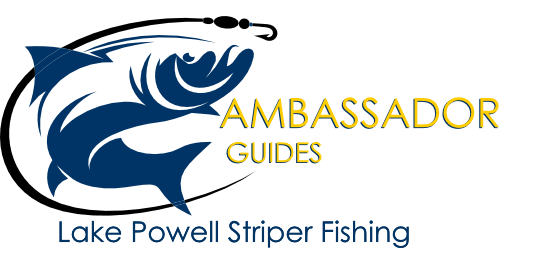Lake Elevation: 3597 Water Temperature 53-60 F
It’s a typical year as bass move on nest sites as the water warms and then pull off as water cools. If the home cove is protected from wind it stays warm and bass spawn. If strong wind cools water then spawning is delayed until the next calm period. The big selling point for coming sooner rather than later to fish for spawning bass is lake level. The lake is stabilizing, ready to start filling. Sight fishing is best in crystal clear water. Rising water causes bank sloughing which clouds the shallow water and reduces visibility. All these factors suggest that the last week of April and first week of May will be the peak time for spring bass fishing success.
Runoff from the Colorado River will cool and muddy the water from Hite to Good Hope Bay. Backs of northern lake canyons will have greater visibility, warmer water and good fishing but with the Hite launch ramp high and dry there is no reason to pass up the great bass fishing at midlake canyons.
There may be other reasons to go north however, as striper and walleye trolling success is increasing. May is the best month to fish for walleye lakewide as they try to recover from spawning stress and rebuild their muscle mass. Walleye search for food continually in these low forage conditions while waiting for shad to spawn and grow. Trolling along muddy shorelines may be the best strategy for walleye.
Striped bass are still found along every shoreline in the southern lake. Bait fishing is the most successful technique as stripers patrol along the canyon walls from the dam to the back of Navajo Canyon. From Padre Bay to Rincon stripers are found in isolated spots along the shoreline and can be readily collected by casting jerk baits (Lucky Craft Pointers) into the shallows. Bait fishing is improving in the Bullfrog area but it is not yet producing the incredible numbers found near the dam. Expect Bullfrog striper bait fishing to improve as water temperature warms into the 60s.
This is my best suggestion for a one-day fishing trip on the southern half of Lake Powell. Water temperature will be cool in the early morning. At dawn go toward the back of the canyon and troll along the shoreline in 25 feet of water with medium running crankbaits or bottom bouncing worm harnesses. Walleye are a low light feeder and may be more aggressive in morning twilight.
When the sun hits the water head to the main channel and fish bait for striped bass along the canyon wall. Chum a spot to locate fish. If they don’t bite within 10 minutes move on and repeat until a school lights up. Catch stripers all morning long. Fill the cooler as many times as needed stopping to fillet fish as space runs out. Then take a lunch break.
As water warms into the 60s in the afternoon head for the backs of canyons and coves again, this time sight-fishing for bedding bass. Cast hard plastic jerk baits and soft plastic grubs to the shallows while trying to locate bass beds. Without brush, rock structure is the critical feature needed to find fish. Bass will be hiding in rock cracks, humps, rock piles and in tumbleweed piles. Warm water increases fish activity dramatically. Throw long casts in clear water to catch fish before they see you.
As the sun sets, if there is any energy left, try night fishing under the shadow of a green light near the marinas or canyon walls to catch another cooler full of striped bass. That would make it a full day.
Lake Powell currently offers great fishing for all game fish residing in the lake. It is possible to use your favorite fishing technique to catch your favorite warm water fish. The fish are ready, you just have to get here to enjoy the best spring fishing of the year.



